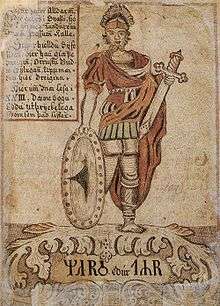Dyeus
Dyēus (Proto-Indo-European: *dyḗws, also *Dyḗus Ph2tḗr, alternatively spelled dyēws) is believed to have been the chief deity in the religious traditions of the prehistoric Proto-Indo-European societies. Part of a larger pantheon, he was the god of the daylit sky, and his position may have mirrored the position of the patriarch or monarch in society.
This deity is not directly attested; rather, scholars have reconstructed this deity from the languages and cultures of later Indo-European peoples such as the Greeks, Latins, and Indo-Aryans. According to this scholarly reconstruction, Dyeus was known as Dyḗus Ph2tḗr, literally "sky father" or "shining father", as reflected in Latin Iūpiter, Diēspiter, possibly Dis Pater and deus pater, Greek Zeu pater, Vedic Dyáuṣ Pitṛ́. As the pantheons of the individual mythologies related to the Proto-Indo-European religion evolved, attributes of Dyeus seem to have been redistributed to other deities. In Greek and Roman mythology, Dyeus remained the chief god; however, in Vedic mythology, the etymological continuant of Dyeus became a very abstract god, and his original attributes and dominance over other gods appear to have been transferred to gods such as Agni or Indra.
Later figures etymologically connected with Dyeus
- In Greek mythology Zeus[1] ([zdeǔ̯s])
- In Roman mythology Jupiter (from *Iou-pater or *Ious-pater)[2]
- In Historical Vedic religion Dyauṣ Pitār[3]
- Dionysus, especially with the Thracians and Sabines
- Possibly Dis Pater (although he is more connected with the Greco-Roman Pluto theologically)
Rooted in the related but distinct Indo-European word *deiwos is the Latin word for deity, deus. The Latin word is also continued in English divine, "deity", and the original Germanic word remains visible in "Tuesday" ("Day of Tīwaz") and Old Norse tívar, which may be continued in the toponym Tiveden ("Wood of the Gods", or of Týr).
.jpg)

The following names derive from the related *deiwos:
- Germanic Tīwaz (known as Týr in Old Norse)
- Latin Deus (originally used to address Jupiter, but later adopted as the name of God)
- Indo-Aryan deva: Vedic/Puranic deva, Buddhist deva
- Armenian: Դիւցազն (dyutsazn) (epic hero, demigod), դիւց (dits), դիք (diq) (Gods), դեւ (dev) (spirit, monster)
- Iranic daeva, daiva, diw, etc.
- Baltic Dievas, deivė (goddess)
- Celtic e.g. Gaulish Dēuos, Gaelic dia, Welsh duw
- Slavic div (genitive divese; "miracle")
- Irish Dagda, from *Dago-deiwos meaning "the good god" or "Shining God"
- Possibly the Lusitanian Reve.[4]
Estonian Tharapita bears similarity to Dyaus Pita in name, although it has been interpreted as being related to the god Thor.
Although some of the more iconic reflexes of Dyeus are storm deities, such as Zeus and Jupiter, this is thought to be a late development exclusive to Mediterranean traditions, probably derived from syncretism with Canaanite deities and Perkwunos.[5] The deity's original domain was over the daylight sky, and indeed reflexes emphasise this connection to light: Istanu (Tiyaz) is a solar deity (though this name may actually refer to a female sun goddess[6]), Helios is often referred to as the "eye of Zeus",[7] in Romanian paganism the Sun is similarly called "God's eye"[8] and in Indo-Iranian tradition Surya/Hvare-khshaeta is similarly associated with Ahura Mazda. Even in Roman tradition, Jupiter often is only associated with diurnal lightning at most, while Summanus is a deity responsible for nocturnal lightning or storms as a whole.
As an ordinary noun
Dyēus's name also likely means "the daytime sky":
- In Sanskrit as div- (nominative singular dyāus with vrddhi), its singular means "the sky" and its plural means "days".
- Its accusative form *dyēm became Latin diem "day", which later gave rise to a new nominative diēs. The original nominative survives as diūs in a few fixed expressions.[9]
- Finnish taivas, Estonian taevas, Livonian tōvaz etc. (from Proto-Finnic *taivas), meaning "heaven" or "sky," are likely rooted in the Indo-European word. The neighboring Baltic Dievas or Germanic Tiwaz are possible sources, but the Indo-Iranian *daivas accords better in both form and meaning. Similar origin has been proposed for the word family represented by Finnish toivoa "to hope" (originally "to pray from gods").
- Old Irish día could mean either "God" or "day"; these give rise to the modern Irish dia and Dé / Scottish Gaelic di- respectively.[10]
See also
References
- ↑ "Zeus". American Heritage Dictionary. Bartleby. Archived from the original on 12 October 2007. Retrieved 2006-07-03.
- ↑ "Indo-European and the Indo-Europeans". American Heritage Dictionary of the English Language (4th ed.). Bartleby. 2000. Archived from the original on 12 October 2007. Retrieved 2008-09-27.
- ↑ Oberlies, Thomas (1998), Die Religion des Rgveda (in German), Wien .
- ↑ Lódz, Krzysztof Tomasz Witczak (1999). "On the Indo-European Origin of Two Lusitanian Theonyms (Laebo and Reve)" (66). Emerita: 65–73.
- ↑ Green, Miranda (1990), "Pagan Celtic Religion: Archaeology and Myth.", Transactions of the Honourable Society of Cymmrodorian: 13–28
- ↑ Jörg Klinger: Untersuchungen zu Rekonstruktion der hattischen Kultschicht; Studien zu den Boǧazköy-Texten 37, Wiesbaden 1996, ISBN 3-447-03667-2
- ↑ Sick, David H. (2004), "Mit(h)ra(s) and the Myths of the Sun", Numen, 51 (4): 432–467, JSTOR 3270454
- ↑ Ionescu, Doina; Dumitrache, Cristiana (2012), "The Sun Worship with the Romanians." (PDF), Romanian Astronomical Journal, 22 (2): 155–166
- ↑ Etymological dictionary of Latin and the other Italic languages, De Vaan, 2008
- ↑ http://edil.qub.ac.uk/15848
Bibliography
- Pokorny, Julius (1959), Indogermanisches etymologisches Wörterbuch (in German) .
Further reading
- "Indo-European *Deiwos and Related Words" by Grace Sturtevant Hopkins, Language Dissertations number XII, December 1932 (supplement to Language, journal of the Linguistic Society of America).